Brother DCP-116C User Manual
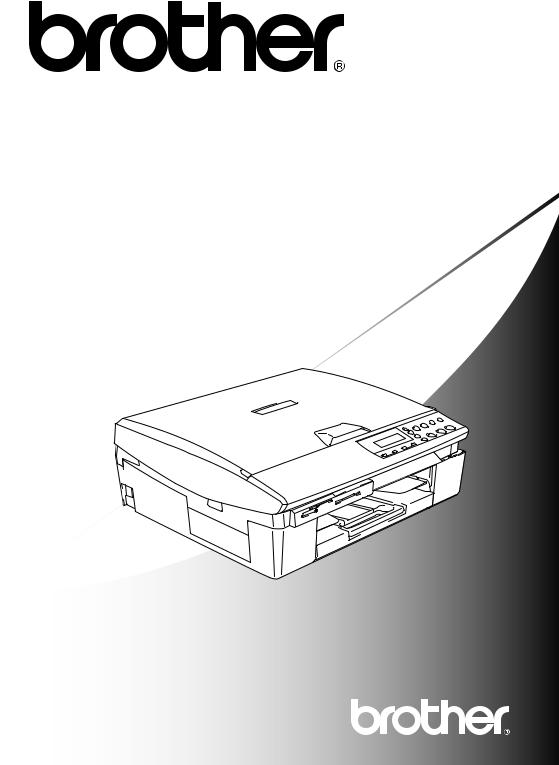
USER’S GUIDE
DCP-115C
DCP-116C
DCP-120C
DCP-315CN

If you need to call Customer Service
Please complete the following information for future reference:
Model Number: DCP-115C, DCP-116C, DCP-120C and DCP-315CN (Circle your model number)
Serial Number:*
Date of Purchase:
Place of Purchase:
*The serial number is on the back of the unit. Retain this User’s Guide with your sales receipt as a permanent record of your purchase, in the event of theft, fire or warranty service.
Register your product on-line at
http://www.brother.com/registration/
By registering your product with Brother, you will be recorded as the original owner of the product.
©1996-2005 Brother Industries, Ltd.

Compilation and Publication Notice
Under the supervision of Brother Industries Ltd., this manual has been compiled and published, covering the latest product descriptions and specifications.
The contents of this manual and the specifications of this product are subject to change without notice.
Brother reserves the right to make changes without notice in the specifications and materials contained herein and shall not be responsible for any damages (including consequential) caused by reliance on the materials presented, including but not limited to typographical and other errors relating to the publication.
i
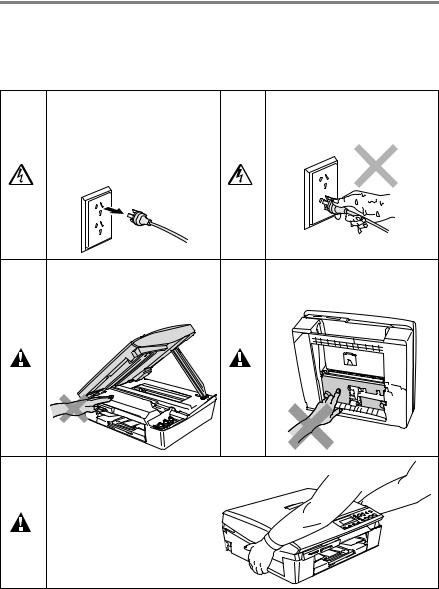
Safety precautions
To use the machine safely
Please refer to these instructions for later reference and before attempting any maintenance.
 WARNING
WARNING
There are high voltage |
Do not handle the plug with wet |
electrodes inside the machine. |
hands. Doing this might cause |
Before you clean the machine, |
an electrical shock. |
make sure you have |
|
unplugged the power cord from |
|
the electrical socket. |
|
To prevent injuries, be careful |
To prevent injuries, be careful |
not to put your hands on the |
not to touch the area shaded in |
edge of the machine under the |
the illustration. |
scanner cover. |
|
When you move the machine, place a hand at each side of the unit so you are supporting the base when you lift it. (See the illustration on the right.) Do not carry the machine by holding the scanner cover.
 Most of the illustrations in this User’s Guide show the DCP-115C.
Most of the illustrations in this User’s Guide show the DCP-115C.
ii
 WARNING
WARNING
This product must be installed near an electrical socket that is easily accessible. In case of emergencies, you must disconnect the power cord from the electrical socket in order to shut off power completely.
 Caution
Caution
To maintain the best print quality, we recommend that you use the On/Off key to turn off your machine. Do not unplug the power cord from the electrical socket, unless moving the machine or performing maintenance. If you need to disconnect your machine from the power, you will need to set the date and time again. (See Quick Setup Guide.)
iii

Choosing a location
Place your machine on a flat, stable surface that is free of vibration and shocks, such as a desk. Put the machine near a standard, grounded electrical socket. Select a location where the temperature remains between 10° and 35°C.
 Caution
Caution
■Avoid placing your machine in a high-traffic area.
■Avoid placing your machine on the carpet.
■Do not place near heaters, air conditioners, water, chemicals, or refrigerators.
■Do not expose the machine to direct sunlight, excessive heat, moisture, or dust.
■Do not connect your machine to electrical sockets controlled by wall switches or automatic timers.
■Disruption of power can wipe out information in the machine’s memory.
■Do not connect your machine to electrical sockets on the same circuit as large appliances or other equipment that might disrupt the power supply.
iv
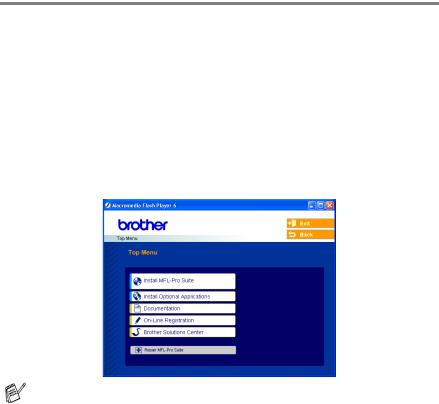
How to access the complete User’s Guide
This User’s Guide does not contain all the information about the machine such as how to use the advanced features of the Printer, Scanner and Network. When you are ready to learn detailed information about these operations, read the complete User’s Guide located in the ‘Documentation’ section of the CD-ROM.
 Network is available only for DCP-315CN.
Network is available only for DCP-315CN.
To view Documentation (For Windows®)
From the Start menu, select Brother, MFL Pro Suite DCP-XXXX
(where XXXX is your model name) from the Programs Group, and then select User’s Guide.
—OR—
1 Turn on your PC. Insert the Brother CD-ROM labelled Windows® into your CD-ROM drive.
2
3
If the model name screen appears, click your model name.
If the language screen appears, click your language.
The CD-ROM main menu will appear.
If this window does not appear, use Windows® Explorer to run the setup.exe program from the root directory of the Brother CD-ROM.
4 Click Documentation.
v
5 Click the documentation you want to read.
■Quick Setup Guide: Setup and Software Installation Instructions
■User’s Guide (3 manuals): User’s Guide for stand-alone operations, Software User’s Guide and Network User’s Guide (DCP-315CN only)
■PaperPort® User’s Guide: Document Management Software
How to find Scanning instructions
There are several ways you can scan documents. You can find the instructions as follows:
Software User’s Guide:
■Scanning on page 2-1
(For Windows® 98/98SE/Me/2000 Professional and Windows® XP)
■ControlCenter2 on page 3-1
(For Windows® 98/98SE/Me/2000 Professional and Windows® XP)
■Network Scanning (DCP-315CN only) on page 4-1
PaperPort® User’s Guide
■ Instructions for scanning directly from ScanSoft® PaperPort®
vi
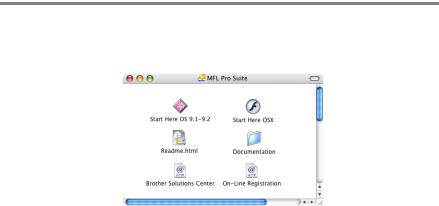
To view Documentation (For Macintosh®)
1 Turn on your Macintosh®. Insert the Brother CD-ROM labelled Macintosh® into your CD-ROM drive. The following window will appear.
2
3
4
(Mac OS® X)
Double-click the Documentation icon.
The select Language screen appears, double-click your language.
Click the documentation you want to read.
■Quick Setup Guide: Setup and Software Installation Instructions
■User’s Guide (3 manuals): User’s Guide for stand-alone operations, Software User’s Guide and Network User’s Guide (DCP-315 CN only)
How to find Scanning instructions
There are several ways you can scan documents. You can find the instructions as follows:
Software User’s Guide:
■Scanning on page 9-1
(For Mac OS® 9.1-9.2/Mac OS® X 10.2.4 or greater)
■ControlCenter2 (For Mac OS® X 10.2.4 or greater) on page 10-1
■Network Scanning (DCP-315CN only) (For Mac OS® X 10.2.4 or greater) on page 11-1
Presto!® PageManager® User’s Guide
■ Instructions for scanning directly from Presto!® PageManager®
vii

Table of Contents
1 |
Introduction .......................................................................... |
1-1 |
|
Using this Guide ............................................................... |
1-1 |
|
Finding information ..................................................... |
1-1 |
|
Symbols used in this Guide ........................................ |
1-1 |
|
Control panel overview ..................................................... |
1-2 |
|
Warning LED indications ............................................ |
1-4 |
|
Load documents ............................................................... |
1-5 |
|
Using the ADF (automatic document feeder) |
|
|
(DCP-120C only) .................................................... |
1-5 |
|
Using the scanner glass ............................................. |
1-7 |
|
About paper ...................................................................... |
1-8 |
|
Recommended Paper................................................. |
1-8 |
|
Handling and using special paper............................... |
1-9 |
|
Paper type and size for each operation................ |
1-10 |
|
Paper weight, thickness and capacity .................. |
1-11 |
|
Paper capacity of the output paper tray ............... |
1-11 |
|
Printable area ....................................................... |
1-12 |
|
How to load paper, envelopes and post cards.......... |
1-13 |
|
To load paper or other media ............................... |
1-13 |
|
To load envelopes ................................................ |
1-15 |
|
To load post cards ................................................ |
1-16 |
2 |
Making copies ...................................................................... |
2-1 |
|
Using the machine as a copier ......................................... |
2-1 |
|
Making a single copy .................................................. |
2-1 |
|
Making multiple copies ............................................... |
2-1 |
|
Stop copying............................................................... |
2-1 |
|
Using the Copy keys ........................................................ |
2-2 |
|
Increasing copy speed or quality ................................ |
2-3 |
|
Enlarging or reducing the image copied ..................... |
2-4 |
|
Changing the temporary copy settings ....................... |
2-6 |
|
Setting paper type .................................................. |
2-7 |
|
Setting paper size................................................... |
2-7 |
|
Adjusting brightness ............................................... |
2-8 |
|
Sorting copies using the ADF (DCP-120C only)..... |
2-8 |
|
Making N in 1 copies or a poster (Page Layout)......... |
2-9 |
|
Changing the default copy settings................................. |
2-12 |
|
Setting Paper Type................................................... |
2-12 |
|
Setting Paper Size .................................................... |
2-13 |
|
Increasing copy speed or quality .............................. |
2-13 |
|
Adjusting brightness ................................................. |
2-14 |
viii

|
Adjusting contrast ..................................................... |
2-14 |
|
Adjusting Colour saturation ...................................... |
2-15 |
|
Legal limitations.............................................................. |
2-16 |
3 |
Walk-Up PhotoCapture Center™ ......................................... |
3-1 |
|
Introduction....................................................................... |
3-1 |
|
PhotoCapture Center™ requirements..................... |
3-2 |
|
Getting started .................................................................. |
3-3 |
|
Printing the Index (Thumbnails)........................................ |
3-5 |
|
Printing images................................................................. |
3-6 |
|
DPOF printing............................................................. |
3-8 |
|
Changing the default settings ........................................... |
3-9 |
|
Increasing print speed or quality................................. |
3-9 |
|
Setting paper and size................................................ |
3-9 |
|
Adjusting brightness ................................................. |
3-10 |
|
Adjusting contrast ..................................................... |
3-10 |
|
Colour enhancement ................................................ |
3-11 |
|
Cropping ................................................................... |
3-12 |
|
Borderless ................................................................ |
3-13 |
|
Scan to Card (DCP-115C, DCP-120C and |
|
|
DCP-315CN only)....................................................... |
3-13 |
|
Changing the default quality ..................................... |
3-14 |
|
Changing the default black & white file format ......... |
3-15 |
|
Changing the default colour file format..................... |
3-15 |
|
Understanding the Error Messages................................ |
3-16 |
|
Using PhotoCapture Center™ from your computer......... |
3-16 |
4
5
Software and Network features .......................................... |
4-1 |
Important information ......................................................... |
5-1 |
For your safety............................................................ |
5-1 |
LAN connection (DCP-315CN only) ........................... |
5-1 |
International ENERGY STAR® |
|
Compliance Statement ........................................... |
5-1 |
Important safety instructions....................................... |
5-2 |
Trademarks ................................................................ |
5-4 |
6 |
Troubleshooting and routine maintenance ....................... |
6-1 |
|
Troubleshooting................................................................ |
6-1 |
|
Error messages .......................................................... |
6-1 |
|
Document jams (DCP-120C only) .............................. |
6-3 |
|
Document is jammed in the top of the ADF unit....... |
6-3 |
|
Document is jammed inside the ADF unit .............. |
6-3 |
|
Printer jam or paper jam ............................................. |
6-4 |
ix

|
Paper is jammed inside the paper tray ................... |
6-4 |
|
Paper is jammed inside the machine...................... |
6-5 |
|
If you are having difficulty with your machine ............. |
6-7 |
|
How to change LCD language.................................. |
6-10 |
|
How to improve the LCD viewing.............................. |
6-10 |
|
Setting the Beeper Volume....................................... |
6-10 |
|
How to improve print quality ........................................... |
6-11 |
|
Cleaning the print head............................................. |
6-11 |
|
Checking the print quality ......................................... |
6-12 |
|
Checking the printing alignment ............................... |
6-14 |
|
Checking the ink volume................................................. |
6-15 |
|
Packing and shipping the machine ................................. |
6-16 |
|
Routine maintenance...................................................... |
6-19 |
|
Cleaning the scanner................................................ |
6-19 |
|
Cleaning the machine printer platen......................... |
6-20 |
|
Cleaning the Paper Pick-up Roller............................ |
6-21 |
|
Replacing the ink cartridges ..................................... |
6-22 |
A |
Appendix .............................................................................. |
A-1 |
|
On-screen programming.................................................. |
A-1 |
|
Menu table ................................................................. |
A-1 |
|
Printing reports .......................................................... |
A-1 |
|
Menu keys ....................................................................... |
A-2 |
S |
Specifications ...................................................................... |
S-1 |
|
Product description .......................................................... |
S-1 |
|
General ............................................................................ |
S-1 |
|
Print media....................................................................... |
S-2 |
|
Copy ................................................................................ |
S-3 |
|
PhotoCapture Center™ .................................................... |
S-4 |
|
Scanner ........................................................................... |
S-5 |
|
Printer .............................................................................. |
S-6 |
|
Interfaces ......................................................................... |
S-6 |
|
Computer requirements ................................................... |
S-7 |
|
Consumable items ........................................................... |
S-8 |
|
Network (LAN) (DCP-315CN only) .................................. |
S-9 |
|
Index ....................................................................................... |
I-1 |
x
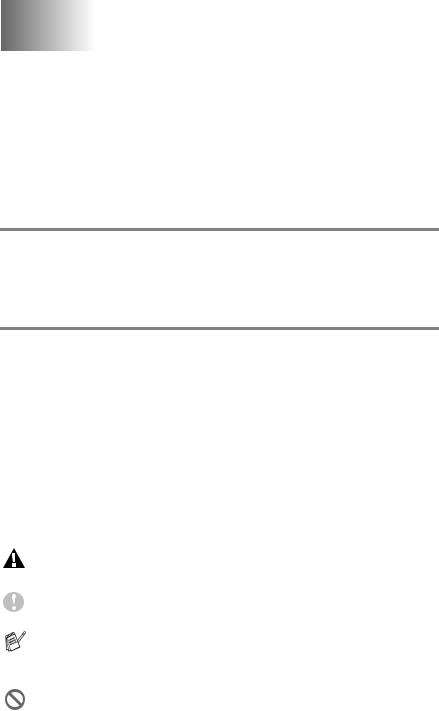
1 Introduction
Using this Guide
Thank you for buying a Brother Digital Copier/Printer (DCP). Your machine is simple to use, with LCD screen instructions to guide you through programming it. You can make the most of your machine by reading through this Guide.
Finding information
All the chapter headings and subheadings are listed in the Table of Contents. You will be able to find information about a specific feature or operation by checking the Index at the back of this Guide.
Symbols used in this Guide
Throughout this Guide you will see special symbols alerting you to important warnings, notes and actions. To make things clearer and to help you press the correct keys, we used special fonts and added some of the messages that will appear in the LCD.
Bold |
Bold typeface identifies specific keys on the machine |
|
control panel. |
Italics |
Italicized typeface emphasizes an important point or |
|
refers you to a related topic. |
Courier New Courier New type face identifies the messages on the LCD of the machine.
Warnings inform you what to do to avoid possible personal injury.
Cautions specify procedures you must follow or avoid to prevent possible damage to the machine or other objects.
Notes tell you how you should respond to a situation that may arise or give tips about how the operation works with other features.
Improper Setup alerts you to devices and operations that are not compatible with the machine.
INTRODUCTION 1 - 1
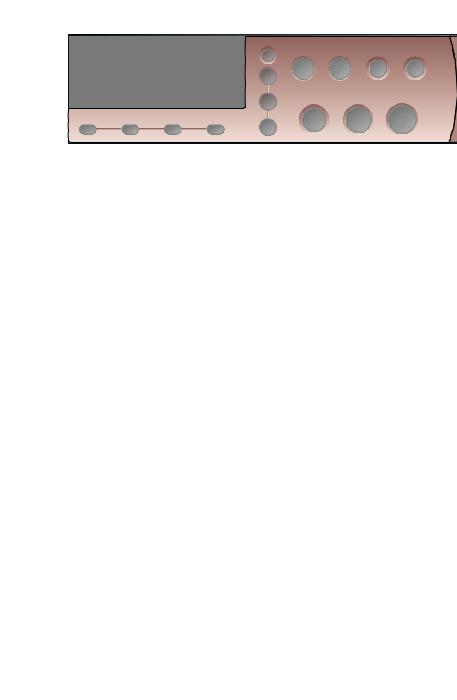
Control panel overview
11 |
10 |
9 |
8 |
7 |
6 |
|||
|
|
|
|
|
|
|
|
|
|
|
|
|
|
|
|
|
|
|
|
|
|
|
|
|
|
|
|
|
|
|
|
|
|
|
|
|
|
|
|
|
|
|
|
|
|
|
|
|
|
|
|
|
|
1 |
2 |
3 |
4 |
5 |
1 Copy keys |
|
2 Menu keys: |
|
|
(Temporary settings): |
|
Menu |
|
|
|
|
|
|
|
Copy Options |
|
Lets you access the Menu to |
||
You can quickly and easily select |
|
program. |
|
|
temporary settings for copying. |
|
+ |
or - |
|
Enlarge/Reduce |
|
|
||
|
Press to scroll through the menus |
|||
Lets you enlarge or reduce copies |
|
|||
|
and options. |
|
||
depending on the ratio you select. |
|
Also you can use these keys to |
||
|
|
|||
Copy Quality |
|
enter the number. |
|
|
Use this key to temporarily change |
|
Set |
|
|
the quality for copying. |
|
Lets you store your settings in the |
||
|
|
|||
Number of Copies |
|
machine. |
|
|
Use this key to make multiple copies.
1 - 2 INTRODUCTION
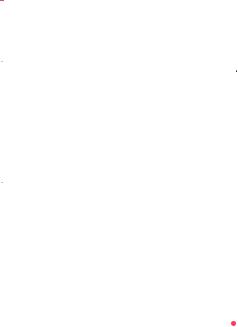
3  Stop/Exit
Stop/Exit
Stops an operation or exits from the menu.
4  Mono Start
Mono Start
Lets you start making copies in black and white.
Also, lets you start a scanning operation (in colour or black, depending on the scanning setting in the ControlCenter2 software).
5  Colour Start
Colour Start
Lets you start making copies in full colour.
Also, lets you start a scanning operation (in colour or black, depending on the scanning setting in the ControlCenter2 software).
6  On/Off
On/Off
You can turn the machine on or off. If you turn the machine off, it will still periodically clean the print head to maintain print quality.
7  Ink Management
Ink Management
Lets you clean the print head, check the print quality, and check the available ink volume.
8  Scan
Scan
Lets you access Scan mode.
9  PhotoCapture
PhotoCapture
Lets you access the PhotoCapture
Center™.
0Liquid Crystal Display (LCD)
Displays messages on the screen to help you set up and use your machine.
The LCD examples in this guide are for models with a one-line display. There may be slight differences between the examples provided and models with a two-line display.
A  Warning LED
Warning LED
Turns red when LCD displays an error or an important status message.
INTRODUCTION 1 - 3
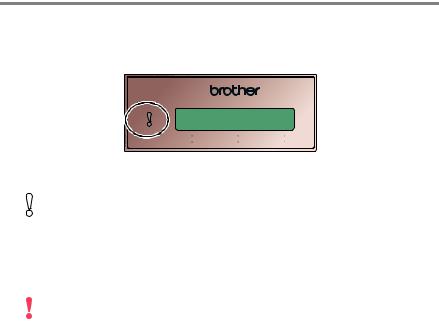
Warning LED indications
The Warning LED (Light Emitting Diode) lights when there is a problem with your machine. You should check the LCD displays for more details about the problem.
LED |
Machine status |
Description |
|
|
|
|
|
|
|
Ready |
The machine is ready for use. |
Off |
|
|
|
|
|
|
|
|
|
Cover open |
The cover is open. Close the cover. (See Error |
|
|
|
messages on page 6-1.) |
|
|
|
|
|
|
Ink empty |
Replace the Ink cartridge with a new one. (See |
|
|
|
Replacing the ink cartridges on page 6-22.) |
|
|
|
|
Red |
Paper error |
Put paper in the tray or clear the paper jam. |
|
|
Check the LCD message. (See Troubleshooting |
||
|
|
|
and routine maintenance on page 6-1.) |
|
|
|
|
|
|
Others |
Check the LCD message. (See Troubleshooting |
|
|
|
and routine maintenance on page 6-1.) |
|
|
|
|
1 - 4 INTRODUCTION

Load documents
You can make copies and scan from the ADF (automatic document feeder) or from the scanner glass (flatbed).
Using the ADF (automatic document feeder) (DCP-120C only)
The ADF can hold up to 10 pages and feeds each sheet individually. Use standard (80 gsm) paper and always fan the pages before putting them in the ADF.
DO NOT use paper that is curled, wrinkled, folded, ripped, stapled, paper clipped, pasted or taped.
DO NOT use cardboard, newspaper or fabric. (To copy or scan this kind of document, see Using the scanner glass on page 1-7.)
Recommended environment
Temperature: 20 to 35°C
Humidity: 50 to 70%
Paper: 80 gsm A4
Available document
Length: 147 to 356 mm
Width: 147 to 216 mm
Weight: 64 to 90 gsm
■Make sure documents written with ink or correction fluid are completely dry.
INTRODUCTION 1 - 5

1 Fan the pages well. Make sure you put the documents face down, top edge first in the ADF until you feel them touch the
2
3
feed roller.
Adjust the paper guides to fit the width of your documents.
Unfold the ADF Document Output Support Flap.
ADF Document
Output Support Flap
DO NOT pull on the document while it is feeding.
To use the ADF, the scanner glass must be empty.
1 - 6 INTRODUCTION

Using the scanner glass
You can use the scanner glass to copy or scan pages of a book or one page at a time. Documents can be up to 216 mm wide and 297 mm long.
(DCP-120C only) To use the scanner glass, the ADF must be empty.
1 Lift the document cover.
Place documents face down on the Scanner Glass
2 Using the document guidelines on the left, center the document face down on the scanner glass.
3 Close the document cover.
If the document is a book or is thick, do not slam the cover or press on it.
INTRODUCTION 1 - 7
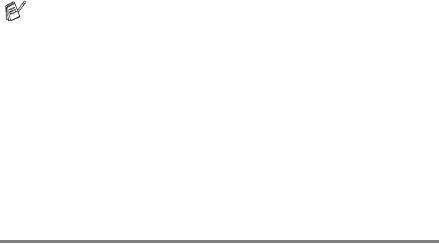
About paper
The print quality can be affected by the type of paper you use in the machine.
To get the best print quality for the settings you’ve chosen, always set the Paper Type to match the type of paper you load.
You can use plain paper, inkjet paper (coated paper), glossy paper, transparencies and envelopes.
We recommend testing various paper types before purchasing large quantities.
For best results, use the recommended paper.
■When you print on inkjet paper (coated paper), transparencies and glossy paper, be sure to select the proper media in the “Basic” tab of the printer driver or in the Paper Type setting of the menu.
■When you print on Brother glossy paper, load the instruction sheet included with the glossy paper in the paper tray first, and then place the glossy paper on the instruction sheet.
■When you use transparencies or glossy paper, remove each sheet immediately to prevent smudging or paper jams.
■Avoid touching the printed surface of the paper immediately after printing. The surface may not be completely dry and may stain your fingers.
Recommended Paper
To get the best print quality, we suggest using Brother paper. (See table below.)
If Brother paper is not available in your country, we recommend testing various papers before purchasing large quantities.
We recommend using “3M Transparency Film” when you print on transparencies.
Brother Paper
Paper Type |
Item |
|
|
A4 Plain |
BP60PA |
|
|
A4 Glossy |
BP60GLA |
|
|
A4 Inkjet (Photo Matte) |
BP60MA |
|
|
10 x 15 cm Glossy |
BP60GLP |
|
|
1 - 8 INTRODUCTION
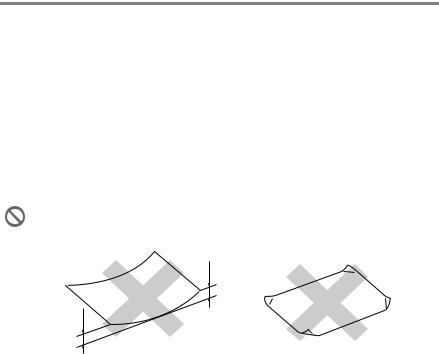
Handling and using special paper
■Store paper in its original packaging, and keep it sealed. Keep the paper flat and away from moisture, direct sunlight and heat.
■The coated side of glossy paper is shiny. Avoid touching the shiny (coated) side. Load glossy paper with the shiny side facing down.
■Avoid touching either side of transparencies because they absorb water and perspiration easily, and this may cause decreased output quality. Transparencies designed for laser printers/copiers may stain your next document. Use only transparencies recommended for inkjet printing.
Do not use paper:
■ that is damaged, curled, wrinkled, or irregularly shaped
2 mm or longer
2 mm or longer
■that is extremely shiny or highly textured
■that was previously printed by a printer
■that cannot be arranged uniformly when stacked
■that is made with a short grain
INTRODUCTION 1 - 9
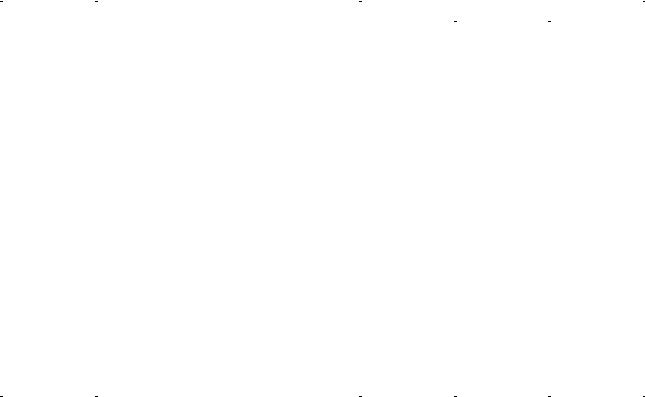
INTRODUCTION 10 - 1
Paper type and size for each operation
Paper Type |
Paper Size |
|
|
Usage |
|
|
|
|
|
|
|
|
|
|
Copy |
PhotoCapture |
Printer |
|
|
|
|
|
|
Cut Paper |
Letter |
216 x 279 mm (8 1/2" x 11") |
Yes |
Yes |
Yes |
|
A4 |
210 x 297 mm (8.3" x 11.7") |
Yes |
Yes |
Yes |
|
Legal |
216 x 356 mm (8 1/2" x 14") |
Yes |
— |
Yes |
|
Executive |
184 x 267 mm (7 1/4" x 10 1/2") |
— |
— |
Yes |
|
JIS B5 |
182 x 257 mm (7.2" x 10.1") |
— |
— |
Yes |
|
A5 |
148 x 210 mm (5.8" x 8.3") |
Yes |
— |
Yes |
|
A6 |
105 x 148 mm (4.1" x 5.8") |
— |
— |
Yes |
|
|
|
|
|
|
Cards |
Photo |
102 x 152 mm (4" x 6") |
Yes |
Yes |
Yes |
|
Photo L |
89 x 127 mm (3 1/2" x 5") |
— |
— |
Yes |
|
Photo 2L |
127 x 178 mm (5" x 7") |
— |
Yes |
Yes |
|
Index Card |
127 x 203 mm (5" x 8") |
— |
— |
Yes |
|
Post Card 1 |
100 x 148 mm (3.9" x 5.8") |
— |
— |
Yes |
|
Post Card 2 |
148 x 200 mm (5.8" x 7.9") |
— |
— |
Yes |
|
(Double) |
|
|
|
|
|
|
|
|
|
|
Envelopes |
C5 Envelope |
162 x 229 mm (6.4" x 9") |
— |
— |
Yes |
|
DL Envelope |
110 x 220 mm (4.3" x 8.7") |
— |
— |
Yes |
|
COM-10 |
105 x 241 mm (4 1/8" x 9 1/2") |
— |
— |
Yes |
|
Monarch |
98 x 191 mm (3 7/8" x 7 1/2") |
— |
— |
Yes |
|
JE4 Envelope |
105 x 235 mm (4.1" x 9.3") |
— |
— |
Yes |
|
|
|
|
|
|
Transparencies |
Letter |
216 x 279 mm (8 1/2" x 11") |
Yes |
— |
Yes |
|
A4 |
210 x 297 mm (8.3" x 11.7") |
Yes |
— |
Yes |
|
|
|
|
|
|

Paper weight, thickness and capacity
Paper Type |
|
Weight |
Thickness |
No. of sheets |
|
|
|
|
|
Cut Paper |
Plain Paper |
64 to 120 gsm |
0.08 to 0.15 mm |
100* |
|
|
(17 to 32 lb) |
(0.003" to 0.006") |
|
|
|
|
|
|
|
Inkjet Paper |
64 to 200 gsm |
0.08 to 0.25 mm |
20 |
|
|
(17 to 53 lb) |
(0.003" to 0.01") |
|
|
|
|
|
|
|
Glossy Paper |
Up to 220 gsm |
Up to 0.25 mm |
20 |
|
|
(Up to 58 lb) |
(Up to 0.01") |
|
|
|
|
|
|
Cards |
Photo Card |
Up to 240 gsm |
Up to 0.28 mm |
20 |
|
|
(Up to 64 lb) |
(Up to 0.01") |
|
|
|
|
|
|
|
Index Card |
Up to 120 gsm |
Up to 0.15 mm |
30 |
|
|
(Up to 32 lb) |
(Up to 0.006") |
|
|
|
|
|
|
|
Post Card |
Up to 200 gsm |
Up to 0.23 mm |
30 |
|
|
(Up to 53 lb) |
(Up to 0.01") |
|
|
|
|
|
|
Envelopes |
|
75 to 95 gsm |
Up to 0.52 mm |
10 |
|
|
(20 to 25 lb) |
(Up to 0.02") |
|
|
|
|
|
|
Transparencies |
|
— |
— |
10 |
|
|
|
|
|
*Up to 50 sheets for Legal size paper (80 gsm).
*Up to 100 sheets of 80 gsm.
Paper capacity of the output paper tray
Output Paper
Tray
Up to 25 sheets of 80 gsm (A4)
■Transparencies or glossy paper must be picked up from the output paper tray one page at a time to avoid smudging.
■Legal paper cannot be stacked on the output paper tray.
INTRODUCTION 1 - 11
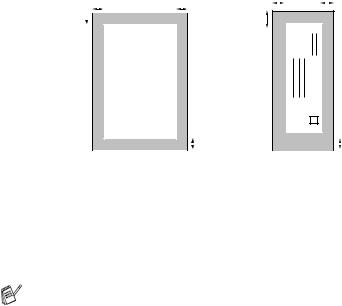
Printable area
The figures below show the unprintable areas on cut sheet paper and envelopes.
Cut Sheet Paper |
Envelopes |
||||||
3 |
4 |
3 |
4 |
||||
|
|
|
|
|
|
||
1
 1
1
|
|
|
|
|
|
|
2 |
|
|
|
2 |
|
|
|
|
|
|
|
|
|
|||||
|
|
|
|
|
|
|
|
|||||
|
■ unprintable area |
|
|
|
|
|
|
|
|
|
||
|
|
|
|
|
|
|
|
|
|
|
|
|
|
|
|
1Top |
2Bottom |
3Left |
|
4Right |
|||||
|
|
|
|
|
|
|
|
|
|
|
|
|
Cut Sheet |
|
|
3 mm |
3 mm |
3 mm |
|
3 mm |
|||||
|
|
|
(0 mm)*1 |
(0 mm)*1 |
(0 mm)*1 |
|
(0 mm)*1 |
|||||
Envelopes |
|
|
12 mm |
24 mm |
3 mm |
|
3 mm |
|||||
|
|
|
|
|
|
|
|
|
|
|
|
|
*1 When you set the Borderless feature to On.
■Printable area depends on the Printer driver settings.
■The figures above are approximate and the printable area may vary depending on the type of cut sheet paper you are using.
1 - 12 INTRODUCTION
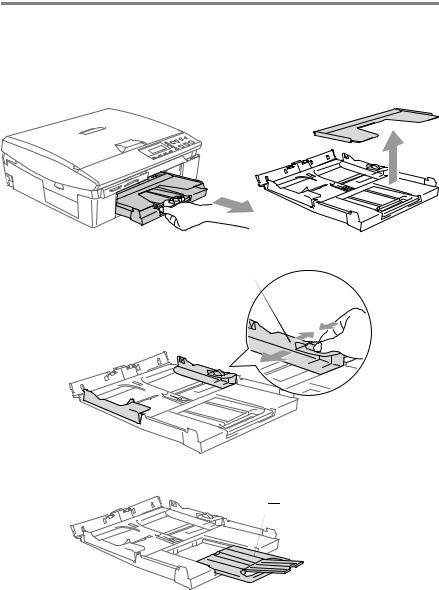
How to load paper, envelopes and post cards
To load paper or other media
1 Pull the paper tray completely out of the machine and remove the output paper tray.
Output Paper Tray
2 Press and slide the paper side guide to fit the paper width.
Paper Side Guide 
3 Pull out the paper support and unfold the paper support flap.
Paper Support
 Paper Support Flap
Paper Support Flap
 Use the paper support flap for Letter, Legal and A4.
Use the paper support flap for Letter, Legal and A4.
INTRODUCTION 1 - 13
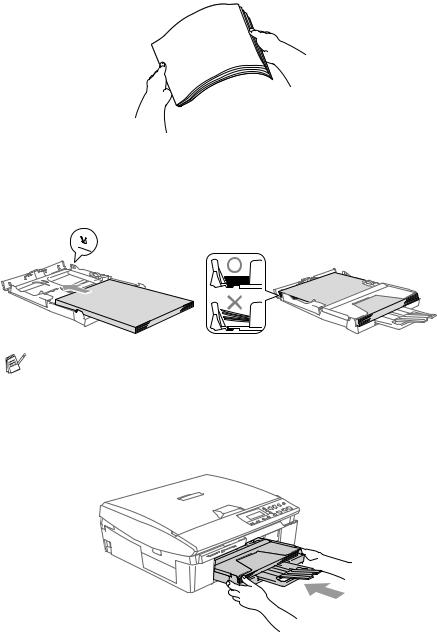
4 Fan the stack of paper well to avoid paper jams and mis-feeds.
5 Gently insert the paper into the paper tray print side down and the leading edge (top of the paper) in first.
Check that the paper is flat in the tray and below the maximum paper mark.

 Maximum Paper Mark
Maximum Paper Mark
■Make sure the paper side guides touch the sides of the paper.
■Be careful that you do not push the paper in too far; it may lift at the back of the tray and cause feed problems.
6 Put the output paper tray back on and push the paper tray firmly back into the machine.
1 - 14 INTRODUCTION
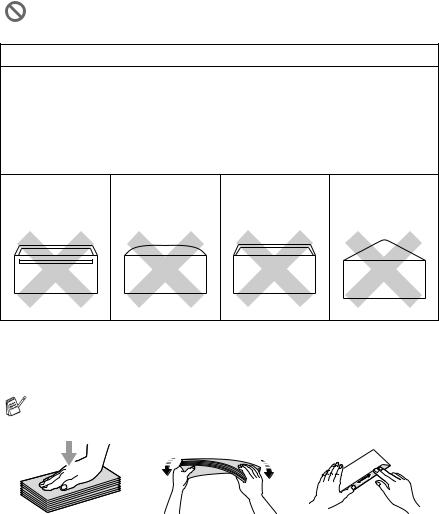
To load envelopes
■Use envelopes that weigh from 75-95 gsm.
■Some envelopes require margin settings in the application. Make sure you do a test print first.
To prevent possible damage to the feeding mechanism, do not use the types of envelopes shown below.
DO NOT USE ENVELOPES:
■that are of a baggy construction
■that are embossed (have raised writing on them)
■that have clasps on them
■that are not sharply creased
■that are preprinted on the inside
■ Glue |
■ Rounded |
■ Double flap |
■ Triangular |
|
flap |
|
flap |
How to load envelopes
1 Before loading, press the corners and sides of the envelopes to make them as flat as possible.
If the envelopes are ‘double-feeding’, put one envelope in the paper tray at a time.
INTRODUCTION 1 - 15

2 Insert the envelopes into the paper tray with the address side down and the leading edge (top of the envelopes) in first. Slide the paper side guide to fit the width of the envelopes.
If you have problems when printing on envelopes, try the following suggestions:
1
2
Open the envelope flap.
Make sure the open flap is either to the side of the envelope or to the back edge of the envelope when printing.
3 Adjust the size and margin in your application.
To load post cards
1 Raise the paper stop and insert the post cards into the paper tray. Slide the paper side guide to fit the width of the post cards.
1 - 16 INTRODUCTION
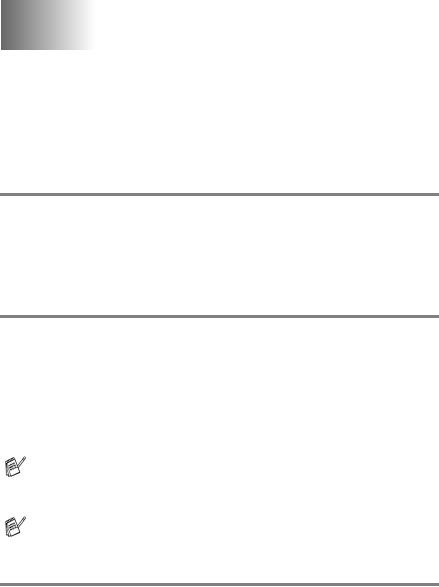
2 Making copies
Using the machine as a copier
You can use your machine as a copier, making up to 99 copies at a time.
Making a single copy
1
2
Load your document.
Press Mono Start or Colour Start.
 To stop copying, press Stop/Exit.
To stop copying, press Stop/Exit.
Making multiple copies
1
2
Load your document.
Press Number of Copies repeatedly until the number of copies you want appears (up to 99).
—OR—
Press  to increase the number of copies. Press
to increase the number of copies. Press  to decrease the number of copies.
to decrease the number of copies.
The number of copies can also be increased/decreased by holding down  or
or  .
.
3 Press Mono Start or Colour Start.
(DCP-120C only) To sort the copies, press the Copy Options key. (See Changing the temporary copy settings on page 2-6.)
Stop copying
To stop copying, press Stop/Exit.
MAKING COPIES 2 - 1

Using the Copy keys
When you want to quickly change the copy settings temporarily for the next copy, use the temporary Copy keys. You can use different combinations.
Temporary Copy keys
These settings are temporary, the machine returns to its default settings 60 seconds after it finishes copying.
You can save the copy settings you use most often by setting them as default. (See Changing the default copy settings on page 2-12.)
2 - 2 MAKING COPIES
